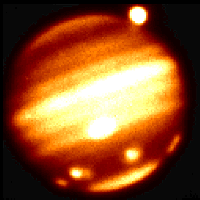

NOTE: Click on the image to view it at its highest resolution.
An image of Jupiter taken from the Calar Alto 3.5 meter telescope on July 18, a few hours after the impact of fragment H from comet Shoemaker Levy 9. The images were taken in the infrared at a wavelength of 1.7 microns in order to enhance the contrast between Jupiter and the impact sites. The bright object just off Jupiter's disk to the upper right is the satellite Ganymede, the large oval near the center is the great red spot, and each of the six fainter blobs near the bottom of the image are impact sites. From the west (underneath Ganymede) to east the spots are: G2,D4,H1,F3,E4,A6 where the letter refers to the impacting fragment and the number refers to the number of times the impact site has rotated into view (i.e. F3 has appeared on the Earth-facing side of Jupiter for the third time). Spots G2,D4 and F3,E4 lie close together. Jupiter rotates once in approximately 10 hours. By the end of this week (22 July), there were fifteen to twenty such spots encircling Jupiter's southern hemisphere like a string of pearls.
Image taken with the MAGIC infrared camera on the 3.5 meter telescope on Calar Alto.
Picture Credits:
Tom Herbst, Max-Planck-Institut fuer Astronomie, Heidelberg, Doug Hamilton, Max-Planck-Institut fuer Kernphysik, Heidelberg, Hermann Boehnhardt, Universitaets-Sternewarte, Muenchen, and Jose Luis Ortiz Moreno, Instituto de Astrofisica de Andalucia, Granada.